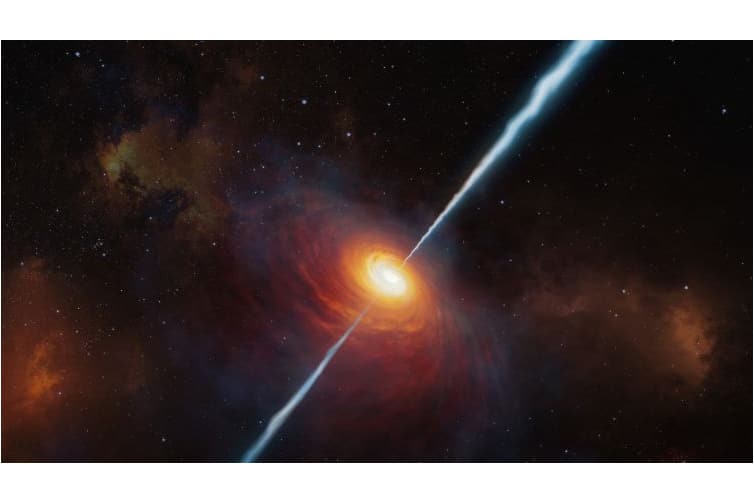We're moving! This site will be relocating to goingto.university in 2026. Please update your bookmarks to the new address.

Scientists from the University of Sheffield have unlocked a historical secret behind quasars. One of the biggest mysteries behind the brightest and most powerful objects in the Universe has been solved by the discovery that galaxies collide to ignite them.

The quasar was first discovered 60 years ago in photographs of starlike objects that seemed unusually blue, appearing to be embedded in a faint fuzzy halo. They emitted wavelengths that differed to all known celestial objects. Maarten Schmidt managed to identify the patterns of their emission lines, understanding a redshift of high magnitude that signified quasars shine as brightly as a trillion stars packed into a volume the size of our Solar System. Nothing so bright had even been seen from so far away – ever since, it has been a mystery as to what can trigger such powerful activity.
Until the publication of new work led by scientists at the University of Sheffield, and the University of Hertfordshire, revealing the discovery that quasars are the consequence of galaxies crashing together.
The astronomers used deep imaging observations from the Isaac Newton Telescope in the Canary Islands to discover the collisions. They observed the presence of distorted structures in the outer regions of the galaxies that are home to quasars.
The great power of quasars poses a significant risk across the universe. When they are ignited, the consequences for entire galaxies can be dramatic and long-lasting – gas can be pushed out of the galaxy, preventing new stars from being formed for billions of years.
At the centre of a galaxy, there is often a supermassive black hole, which has significant amounts of gas. This gas tends to orbit at large distances from galaxy centres, away from the black holes. However, upon a collision between galaxies, the gas is driven back towards the black hole at the centre. Just before the gas is consumed by the black hole, extraordinary amounts of energy in the form of radiation are released. This is what causes the characteristic brilliance of quasars.
This study is a monumental achievement as it is the first time that such a large size sample of quasars has been imaged with this level of sensitivity. By comparing observations of 48 quasars and their host galaxies with images of over 100 non-quasar galaxies, the scientists concluded that galaxies hosting quasars are approximately three times as likely to be interacting or colliding with other galaxies.
Their research has unveiled more knowledge about our Universe, and has provided a significant step forward in our understanding of how these remarkably powerful objects are triggered and fuelled.
Hear from one of the University of Sheffield’s leading researchers of the paper, Professor Clive Tadhunter from the Department of Physics and Astronomy:
“Quasars are one of the most extreme phenomena in the Universe, and what we see is likely to represent the future of our own Milky Way galaxy when it collides with the Andromeda galaxy in about five billion years.
“It’s exciting to observe these events and finally understand why they occur – but thankfully Earth won’t be anywhere near one of these apocalyptic episodes for quite some time.”
The University of Sheffield is proud to have come first in the UK in the Research Excellence Framework 2021 in terms of the quality of our research – 100 per cent of research and impact from our department was rated as world-leading or internationally excellent. The astrophysics research group at the University carry out, amongst other areas, studies on Active Galactic Nuclei (AGN) and quasars, concentrating on X-ray, optical, infrared and radio studies of active galaxies and quasars, to investigate the links between galaxy evolution and nuclear activity.

Quasars are important to astrophysicists because, due to their brightness, they can be seen from large distances. This means they act as beacons to the earliest epochs in the history of the Universe.
The observation of quasars at their great distances means that by the time it takes light to travel to us, when we observe quasars we observe their form in the distant past. The relationship between the increasing density of quasars and a greater distance, means that their presence was more common in the past than now. The most distant, and therefore the earliest, quasars discovered were formed less than a billion years after the big bang.
The paper can be viewed in full here.
To find out more about our Department of Physics and Astronomy at the University of Sheffield, take a look at our webpage here.
If you’re interested in this topic, take a look at our undergraduate courses:
Learn more about University of SheffieldThe latest articles from study abroad providers and StudyLink.com to hep you on your study abroad journey.
See more articlesRead our key advice article to help you make the best decision for your education and start your International study adventure.

In this article we look at how to approach choosing where in the world you would like to study.

Read StudyLink's suggestions on your first steps when deciding where to study abroad, with helpful tips to make your decision easier.

Find out more about English language tests, your options and what is required as an overseas student.

StudyLink.com take a detailed look into the costs of studying abroad and all the aspects that you should budget for when embarking on your studies.

We answer 10 common questions about applying for a student visa to help make your visa application quick and easy.

Find out more about international student visas for studying abroad, as well as how, where and when to apply for yours.

Find out more about funding and scholarships for international students, and what financial assistance might be available to you.

How to choose a course that fits you? Check our top tips on choosing which course is best for you to help you make an informed decision.
Join the StudyLink email list and never miss a chance to turn your study abroad dreams into reality!
